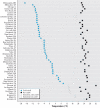Extreme temperatures and mortality: assessing effect modification by personal characteristics and specific cause of death in a multi-city case-only analysis
- PMID: 16966084
- PMCID: PMC1570054
- DOI: 10.1289/ehp.9074
Extreme temperatures and mortality: assessing effect modification by personal characteristics and specific cause of death in a multi-city case-only analysis
Abstract
Background: Extremes of temperature are associated with short-term increases in daily mortality.
Objectives: We set out to identify subpopulations and mortality causes with increased susceptibility to temperature extremes.
Methods: We conducted a case-only analysis using daily mortality and hourly weather data from 50 U.S. cities for the period 1989-2000, covering a total of 7,789,655 deaths. We used distributions of daily minimum and maximum temperature in each city to define extremely hot days (>/= 99 th percentile) and extremely cold days (</= 1st percentile) , respectively. For each (hypothesized) effect modifier, a city-specific logistic regression model was fitted and an overall estimate calculated in a subsequent meta-analysis.
Results: Older subjects [odds ratio (OR) = 1.020 ; 95% confidence interval (CI) , 1.005-1.034], diabetics (OR = 1.035 ; 95% CI, 1.010-1.062) , blacks (OR = 1.037 ; 95% CI, 1.016-1.059) , and those dying outside a hospital (OR = 1.066 ; 95% CI, 1.036-1.098) were more susceptible to extreme heat, with some differences observed between those dying from a cardiovascular disease and other decedents. Cardiovascular deaths (OR = 1.053 ; 95% CI, 1.036-1.070) , and especially cardiac arrest deaths (OR = 1.137 ; 95% CI, 1.051-1.230) , showed a greater relative increase on extremely cold days, whereas the increase in heat-related mortality was marginally higher for those with coexisting atrial fibrillation (OR = 1.059 ; 95% CI, 0.996-1.125) .
Conclusions: In this study we identified several subpopulations and mortality causes particularly susceptible to temperature extremes. This knowledge may contribute to establishing health programs that would better protect the vulnerable.
Figures


References
-
- Applegate WB, Runyan JW, Jr, Brasfield L, Williams ML, Konigsberg C, Fouche C. Analysis of the 1980 heat wave in Memphis. J Am Geriatr Soc. 1981;29:337–342. - PubMed
-
- Armstrong BG. Fixed factors that modify the effects of time-varying factors: applying the case-only approach. Epidemiology. 2003;14:467–472. - PubMed
-
- Bouchama A. The 2003 European heat wave. Intensive Care Med. 2004;30:1–3. - PubMed
-
- Braga AL, Zanobetti A, Schwartz J. The time course of weather-related deaths. Epidemiology. 2001;12:662–667. - PubMed
Publication types
MeSH terms
Grants and funding
LinkOut - more resources
Full Text Sources
Other Literature Sources

